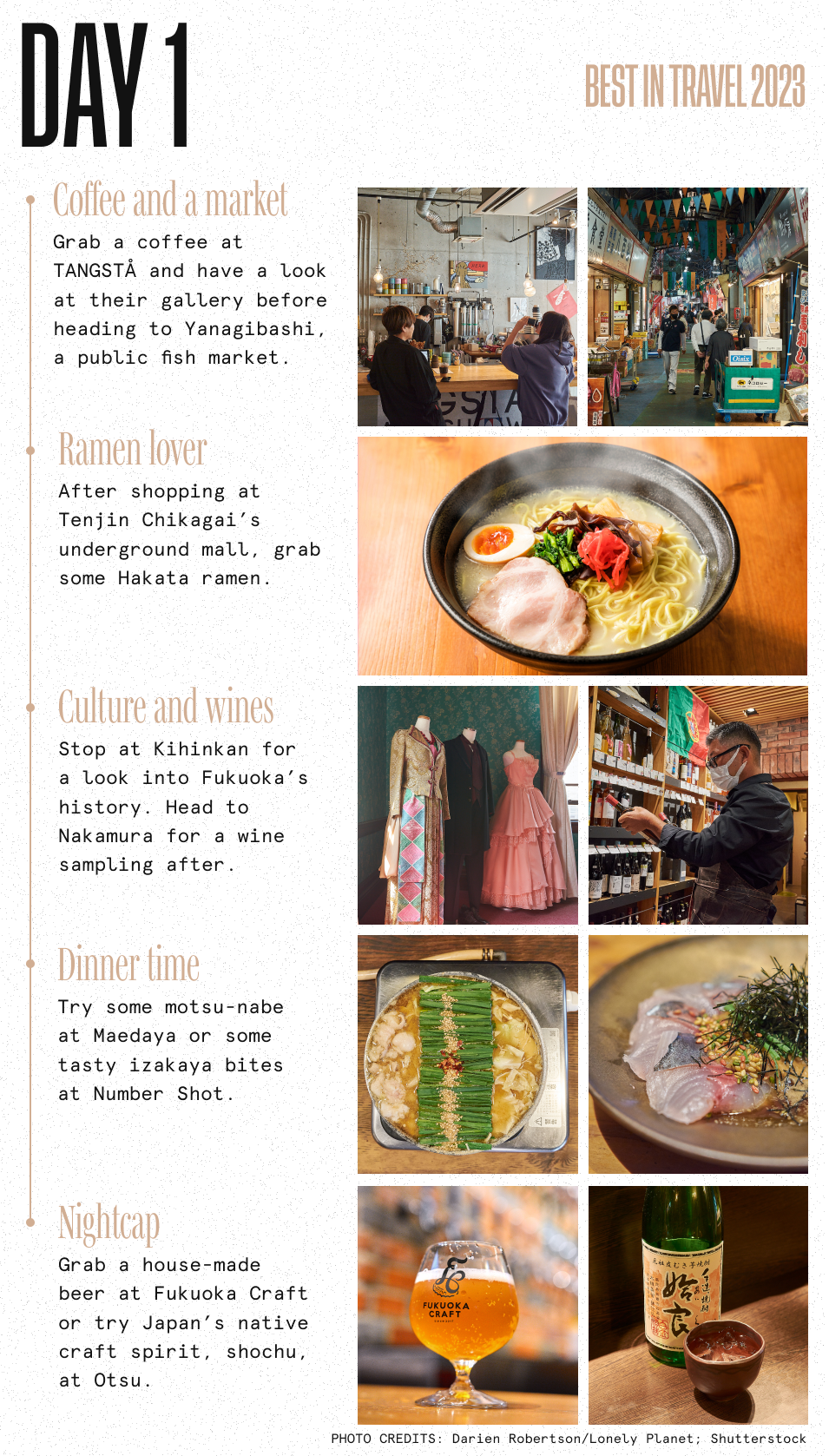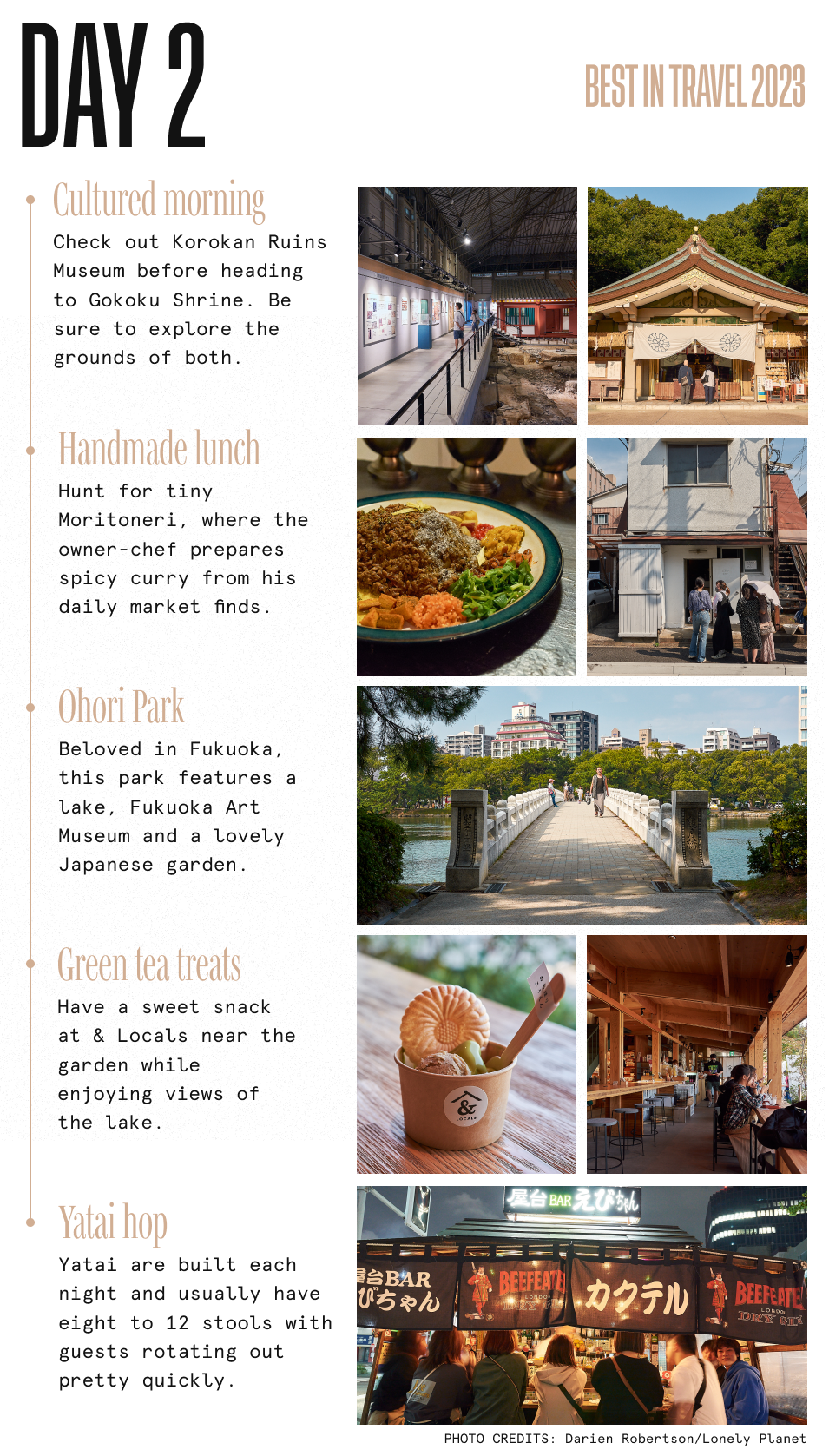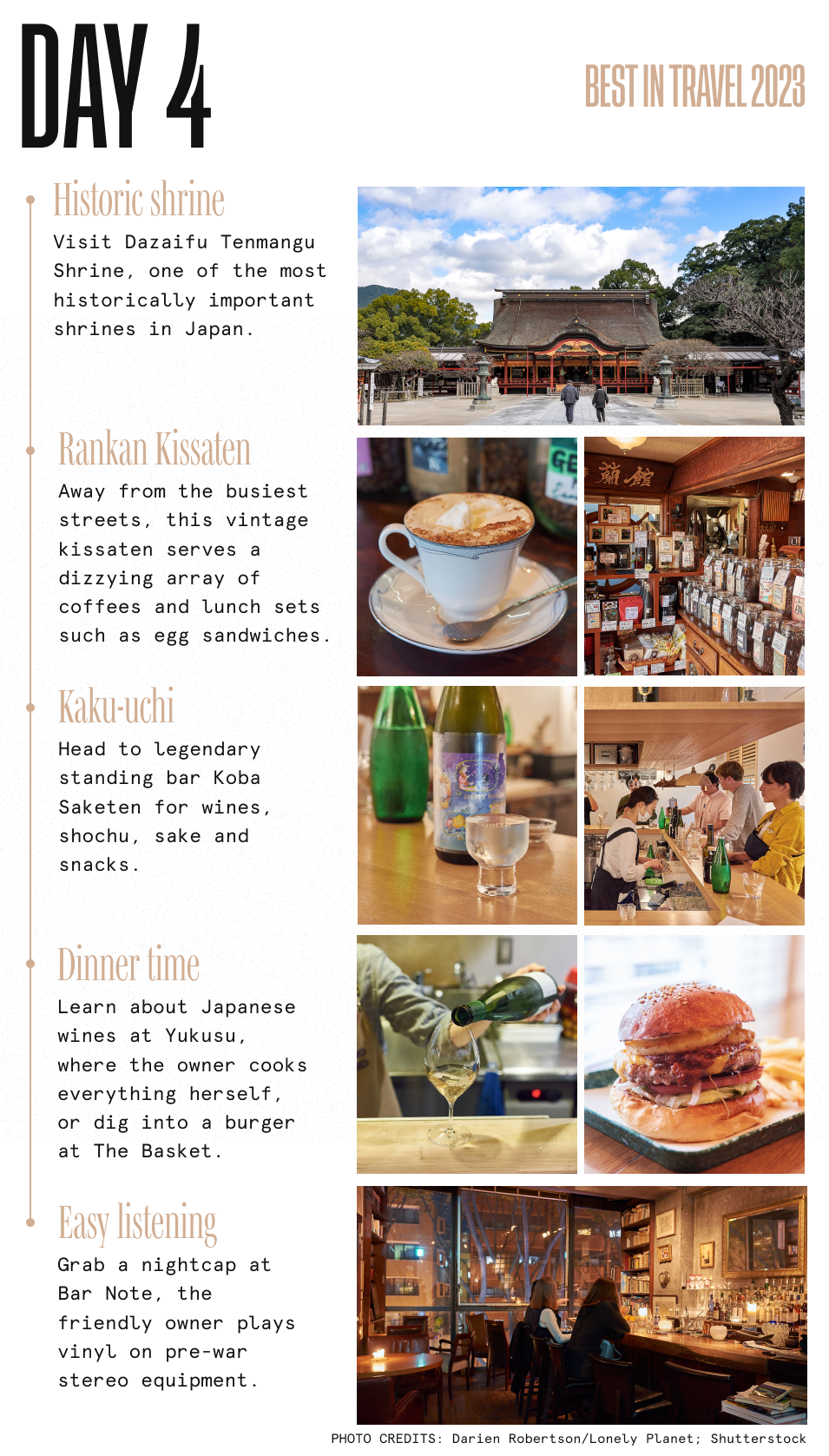Located at the tip of northern Kyūshū, friendly and sunny Fukuoka has a coastal location on a bustling trading route that has historically made it a popular choice to visit in Japan.
But Fukuoka landed on the Best in Travel list for its mouthwatering culinary options, from the incredible mobile food scene to, of course, the internationally renowned Hakata ramen. We think food lovers will find Fukuoka an exciting addition to their must-travel list.
Stephen Lyman shows you where to go if you have four days in Fukuoka.
On my first visit to Fukuoka from New York, I thought, “I want to move here to eat and drink in every one of these places.” A decade later, I am not only living here – I am sharing my favorite spots with you. As the author of the James Beard Award–nominated The Complete Guide to Japanese Drinks, I know a thing or two about where to dine. Because in Japan, food and drink are inseparable.
Why to visit Fukuoka
Fukuoka embodies the dichotomy of Japan: resolutely traditional, unapologetically modern. Fukuoka’s history touches on the very soul of Japan, with its Hakata ramen and pickled cod roe famed throughout the archipelago. Today, it’s a vital international trading center with a robust start-up culture – and the fastest growing city in Japan. After Tokyo, Fukuoka is the most common entry city for second-time visitors to Japan: Asian tourists who come for the shopping and stay for the food. This overlooked destination is a place you’ll find yourself thinking about for years afterward. You may even find yourself hoping to move here, as I did.
Where to stay: I recommend Chuo (Central) Ward rather than Hakata, which is largely a business district. There’s so much more to do in Chuo Ward – and it’s an easy subway ride from Fukuoka International Airport or Hakata Shinkansen station. Depending on your budget, there are several luxury hotel options in this area. For location and quintessential Japanese hospitality, I recommend Hotel Okura, Solaria Nishitetsu Hotel, Nishitetsu Grand Hotel or Hotel New Otani. For budget-minded travelers, Hotel Monterey La Soeur or the brand-new Quintessa Hotel in Tenjin will provide convenience as well as a comfortable place to sleep. If you’re a breakfast person, upgrade to the breakfast plan, as morning dining can be hard to find outside of hotels.
Discover marvelous shopping
There’s little I enjoy more than a morning stroll to an amazing coffee shop – in this case, TAGSTÅ, which has a rotating in-store gallery featuring the work of local artists. Nearby, explore Fukuoka’s only public fish market, Yanagibashi (open 7:30am to 5:30pm; closed Sundays).
Stroll north to Tenjin Minami station. Take the stairs down into the underground shopping mall, Tenjin Chikagai, a dual-corridor shopping area that runs a half kilometer (.3 mile) under central Tenjin with nearly 150 shops popular with locals looking for protection from the elements. These boutiques range from Suzunoya’s kimonos to Kura Chika (an outpost of Yoshida Porter, the popular men’s bag maker). Branching off either corridor are several large department stores (Iwataya is my favorite). Explore the basement levels, which are a veritable cornucopia of deliciousness, with prepared foods of all kinds on one floor and a massive market of premium ingredients on another. Looking for a $200 watermelon? You’ll find one here.
Enjoy Hakata ramen
The most popular food from Fukuoka is Hakata ramen, a rich pork bone-broth noodle soup that’s absolutely addictive. Steps north of Tenjin Chikagai is one of the city’s most famous ramen shops, Shin Shin (open 11am until late night; unless you’re there before noon, there will be a line). If you prefer not to wait, head to Hacchan (10am to 6pm; closed Sundays), where you’ll place your order using a ticket machine, find a seat and wait for your bowl. If you’re feeling hungry, order kaidama (extra noodles, $.75). If you want to eat like a local, get your order “katamen” (al dente).
Whether you prefer shopping, culture or a cocktail, Tenjin has something for everyone come afternoon. Massive department stores provide endless shopping. The nearby Daimyo neighborhood is full of boutiques, cafes and curio shops. To see a wild assortment of Japanese eyeglasses, visit Potato Megane (11am to 7am; closed Wednesday and Thursday), or stop into Manu Coffee for an afternoon refresher and free wi-fi. in If you’re interested in culture, Kihinkan in Tenjin Central Park is a grand hall that used to be a residence for visiting foreigners, while the Fukuoka Art Museum is a short walk north. If a midday tipple appeals, Nakamura Wine Shop serves wine by the glass, while Kakuya Standing Bar will give you a Japanese salaryman standing-bar experience.
Dinner at Maedaya
Dinner options abound in Fukuoka. (Note that most recommended restaurants will need a dinner reservation to assure available seating. Ask your concierge to call if you can’t book online.)
A local specialty is motsu-nabe, or gut stew. I’m not going to sugarcoat it: it’s a dish of vegetables and cow intestines long simmered in a miso broth – and it’s absolutely delicious. I recommend Maedaya in Daimyo: this tiny second-floor izakaya is as local as you’re going to find. If cow innards are a step too far, I recommend Number Shot around the corner. This modern izakaya specializes in local dishes such as a spicy cod-roe omelet and cured mackerel sandwiches, all prepared in an open kitchen. Both places offer the addictive goma saba, mackerel sashimi topped with sesame dressing and nori seaweed.
Japan’s craft spirit: honkaku shochu
Time to drink like a local. Fukuoka is the capital city of Kyūshū, the birthplace of Japan’s native craft spirit, honkaku (authentic) shochu. It’s not an exaggeration to say shochu is Japan’s best-kept secret: there’s more shochu produced in Japan than tequila in Mexico, but almost none of it is exported. By law, honkaku shochu has to be made with koji, the national mold of Japan (yes, there is a national mold here), which is used to make sake, soy sauce, miso and a variety of other fermented delights in Japan. Fukuoka is known for mugi (barley) shochu, but imo (sweet potato) shochu from further south is most popular. Either way, shochu pairs wonderfully with the local cuisine.
Across the street from Maedaya is Oscar Bar, an iconic example of an elevated Japanese cocktail spot. Pick your poison; the bartender will take care of the rest. If a beer is more your speed, Fukuoka Craft offers draft beer, including rotating house-made microbrews. If you’re hunting whisky, Bar Kitchen (which, in fact, has no kitchen) is your destination. Want to try more shochu? Otsu is an izakaya that focuses on the spirit.
Take in history at Fukuoka Castle
Head over to Maizuru Park and Fukuoka Castle (built c 1600) – which, like most Japanese castles, was mostly torn down in a fit of modernization in 1871. To consider earlier history – dating to the Heian Period (794–1185) – it’s worth a detour to the Korokan Ruins Museum to explore all the castle’s nooks and crannies. Continue to the south end of the castle ruins to Gokoku Shrine, a peaceful Shinto sanctuary that encompasses impressively large grounds isolated from the city’s noise by a mature cultivated forest.
One of the beautiful things about Japan is that you can still find sole proprietors making incredible food in an intimate setting. Just west of the shrine, hunt for tiny Moritoneri (open 11:30am–3:30pm daily), where the owner-chef prepares handmade spice curry each day based on what he picks up at market each morning.
Check out Ōhori Park
If there’s a long wait, head to Ōhori Park’s Royal Garden Cafe, whose tables (both indoors and out) overlook a central lake full of turtles, koi and seasonal waterfowl. If you’re in the mood for fine dining, on the second floor you’ll find the classic, reservations-required French restaurant Hananoki, which was made famous by Marilyn Monroe (on her 1954 Japanese honeymoon with Joe DiMaggio, she raved about the French onion soup here). The floor-to-ceiling windows also offer beautiful park views.
Ōhori Park is beloved in Fukuoka. The central feature is the lovely lake with a 2km (1.25-mile) walking path around the perimeter and a series of stone bridges connecting islands through the center. Seasonally, you can rent both paddleboats and rowboats ($4–11 per half hour) for another perspective on the beauty.
In the southeast corner of the park you’ll find the Fukuoka Art Museum, which has both a permanent collection of Japanese and Western art and frequent special programs that might feature original manga or anime art. Just west of the museum is the beautiful Ōhori-kōen Japanese Garden, whose stunning stone work, waterfalls, all-seasons flora and peaceful composition make it a must-visit.
Green tea treats at & Locals cafe
As you exit the garden, you’ll find & Locals cafe, where you can enjoy lake views from large windows along with green tea and treats such as shaved ice in the summer or green-tea cakes year-round. The small on-site shop offers handmade woodwork and other crafts, locally made yuzu kosho (a citrus-pepper paste – and the best condiment on earth) and other foodstuffs, plus drinks to go.
Wander back to the north side of the park to Ōhori Park station. If you have energy, stop by Beerholic for Japanese craft beer and perhaps a snack from the full food menu (the herb fries and fried chicken options are my go-tos).
Yatai hop
Tonight, we won’t need a dinner reservation. Dotted around Tenjin are dozens of yatai, food stands that are assembled each evening then taken down at the end of each night. Yatai usually have eight to 12 stools, with guests rotating out pretty quickly. Visit as many yatai as you like: most will offer ramen, gyoza or yakitori, though you can find other options (Chez Rémy and Telas&Mico, for example, offer European comfort food).
Once you’ve gotten your fill, head to Showa Dori Ave, where, in front of the Bank of Japan, you’ll find two unusual yatai. Megane Coffee & Spirits specializes in pour-over coffee and premium spirits, while Yatai Bar Ebichan is a cocktail bar with a QR-code cocktail menu (though they can make anything you request; my personal favorite is a sweet-potato shochu Negroni). If you’re feeling peckish, order Ebichan’s Hakata pizza, flatbread with mentaiko (spicy pickled cod roe) and takana (pickled mustard greens). It’s my favorite midnight snack.
An island excursion to smell the flowers
Make your way to the Meinohama Ferry Terminal to take the boat to Nokonoshima ($3.15 round trip). This island in Hakata Bay is home to a lovely flower garden, Nokonoshima Island Park. Here, flowers bloom all year long, from brilliant yellow rapeseed blossoms in spring to the dahlias in the fall to the white oxalis in winter. To save a lot of time, hurry off the ferry and take one of the waiting taxis rather than waiting for the island bus to take you up the hill. Beyond the beautiful gardens, the island offers excellent views of Hakata Bay, souvenir shops and other amenities. Several restaurants and cafes dot the flower park – so explore and find something you enjoy.
(If you visit in the winter, we would also recommend the Abe or Masuda oyster huts near Fukuyoshi station. On your walk to the waterfront huts, stop at the Family Mart on the way to pick up drinks, since the huts are BYO.)
Take a taxi, bus or your own feet back to the ferry terminal to return to Fukuoka proper. Then take a taxi to Momochi Seaside Park, which has a beach and central shopping area with waterside bars and cafes, or neighboring Fukuoka Tower, with its observation deck offering views of the city.
A dinner you’ll never forget: Restaurant Sola
Tonight, you can expect to enjoy your best meal of the year – so freshen up, and dress up. You’ll need to book in advance for Restaurant Sola, operated by chef Hiroshi Yoshitake, a native of neighboring Saga prefecture who trained in Paris and earned a Michelin star for his Parisian restaurant of the same name before launching his venture in Fukuoka. Here, he brings a gorgeous space, open kitchen, creative food and extremely professional staff – and his team will deliver a night to remember. The menu changes regularly, but always starts with the salmon roe avocado crisp, an absolutely stunning introduction to his culinary genius. (My mouth started watering as I typed that.) The meat course, meanwhile, is always grilled over locally sourced wood.
If fine dining is not your thing, consider Casime, a stylish Mediterranean gastropub offering everything from seasonal fruits over grilled halloumi cheese to proper lamb kofta, accompanied by locally brewed beer from nearby Fukuoka Craft). You may not usually think of European dining in Japan, but you should: Japanese chefs have a knack for mastering a style of cooking, then elevating it beyond what you’d expect. By way of example, nearby Il Sol Levante is certified to make pizza by the Associazione Verace Pizza Napoletana.
Nightcap at Yorozu
An evening at Sola is enough for one night – yet if you want a nightcap, head to Yorozu (reservations recommended). At this stunning tea house, you can enjoy preparations of fine teas (we love the carefully prepared matcha), cocktails or after-dinner drinks as well as seasonal desserts and small savory bites. If you’d prefer something closer to Tenjin, Bar Leichardt is one of the best whiskey bars in all of Japan. English-speaking owner and spirits expert Yu Sumiyoshi has curated an encyclopedic collection of Japanese whiskies.
A Shinto shrine
Want to move here yet? Today, we’ll stay on the move – though hopefully without too much strain. Travel by train from Nishitetsu Tenjin station to Dazaifu station ($2.80 each way), where you’ll head to the sprawling Dazaifu Tenmangu-gū, one of the most historically important Shinto shrines in Japan. (The name of the current era in Japanese history, Reiwa, comes from an ancient poem that was written in Dazaifu.) The road leading from the station to the shrine is filled with souvenir shops, sweets stands, cafes and perhaps one of the prettiest Starbucks you’ll ever see. Stop for refreshment; shop a bit. The nearby Kyushu National Museum houses a permanent collection of historical relics and stunning examples of Japanese traditional artwork.
Classic coffee culture
It’s time to introduce you to kissaten, classic dine-in-only coffee shops. We think of Japan as a land of green tea – and it is – yet in the rush to modernize during the Meiji Era (1868–1912), coffee culture caught on at European-style cafes. Kissaten came about in the early 20th century as a quiet alternative to these lively cafes, and soon became frequent gathering spots for intellectuals. Today, these traditional Japanese eateries are a place to enjoy a well-made cup of coffee in a serene setting. The oldest in Kyushu is in Fukuoka City (Cafe Brasileiro, open since 1934) – but since we are in Dazaifu, the natural destination is Rankan Kissaten (closed Wednesdays). Away from the busiest streets, this vintage kissaten serves a dizzying array of coffees and lunch options such as egg sandwiches.
Kaku-uchi in Fukuoka
Return by train to Fukuoka and get off at Yakuin station, ready for happy hour. South of the station is Todoroki Saketen Yakuin Stand – an example of what’s known as a kaku-uchi in Fukuoka. It’s a standing bar inside a liquor store, only elevated: while many kaku-uchi have improvised tables made of beer crates with wooden trays for tabletops, Todoroki built out a lovely bar with a glass enclosed wine cellar. The food menu stands out as well, with options ranging from charcuterie to karasumi (Japanese bottarga) – a far cry from the pre-packaged smoked cheese and dried squid available at many kaku-uchi. A few blocks away is Beersonic (open 4–8pm weekdays, 1–5pm weekends), a craft beer store where you can stay and crack one open if you like.
Work your way northwest toward Kego, where you’ll find legendary kaku-uchi Koba Saketen. If you find the liquor store first, walk around to the rear of the building and look for the door with a massive wine corkscrew for a handle. Inside, you’ll find affordable premium sake, shochu, wine and other drinks along with snacks – and many friendly regulars.
Japanese wine at Yukusu
Across the street from Koba is Torikawa Suikyo. While reservations are available upstairs, there’s usually a wait on the ground floor, where you can sit at the counter and watch the chefs grill Fukuoka-style yakitori (grilled chicken skewers). The specialty here is grilled chicken skin, which comes wrapped so tightly around the skewer that it ends up with the texture of a dense meatball. A maximum of eight to 10 skewers per customer applies on busy nights; many diners – like you – will easily reach this. If you’re craving Western food, The Basket offers delicious burgers and craft beer. A final option if you’re curious about Japanese wine (most often made from native grapes or hybrids cultivated to thrive in Japan’s climate) is Yukusu, where the owner pours wines made exclusively in Japan and cooks everything herself.
One last drink
If you’ve paced yourself on your bar crawl, you deserve to sit and have a relaxing drink. Bar Ugle has an interior that offers up the best of modern Japanese interior design, minimalist yet luxurious. If you prefer something more eclectic, Bar Note is run by a friendly, older Japanese man who plays vinyl recordings on pre-war stereo equipment. Or visit my favorite speakeasy, Bar White Space, which occupies the back of an empty art gallery.
Congratulations. You’ve fallen in love with my favorite city in the world.
Want to head to Fukuoka but wish there was someone to plan this out for you? Let Lonely Planet’s sister company Elsewhere take away some of the stress of planning by connecting you with the best local expert to craft your dream trip.





